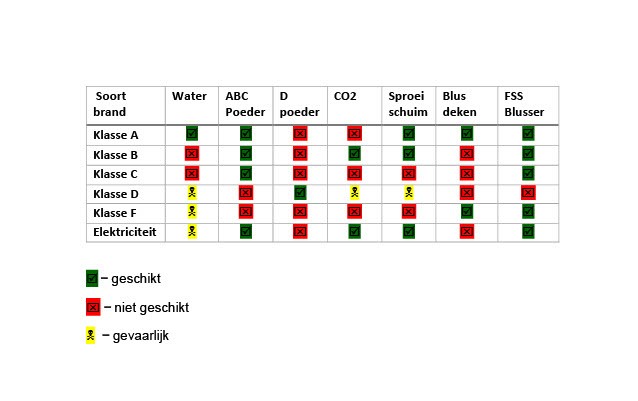Fire, it’s hard to imagine. Yet it happens much more often than we expect. If a fire breaks out somewhere, it is important to start extinguishing it as soon as possible. A fire is often easy to control at the start. There are various extinguishing agents available, but all with their own characteristics and applications. See the following overview.

You can find the answers to the most frequently asked questions below.
If you have any more questions, you can contact us via the contact form.
FSS is a portable pressureless extinguisher with remarkable extinguishing power. It is non-toxic, non-corrosive and environmentally friendly. It is a small lightweight cylinder: the upper part is a metal tube with the extinguishing charge. The lower part is plastic and serves as a handle.
When ignited, the powerful extinguishing charge produces a potassium aerosol jet that lasts for about 25 seconds for the household model, about 50 seconds for the professional model and up to about 100 seconds for the industrial model. Aim the nozzle at the base of the flames to smother the fire in its core.
The FSS is suitable for A, B, C, F and electrical equipment fires up to 1000V. So you never have to think about what you can and cannot do, just extinguish it immediately.
No, there is no collateral damage from the extinguishing agent itself. The gases dissolve and leave no residue.
According to the manufacturer, the shelf life of FSS fire extinguishers is currently guaranteed at 10 years. But because the product is insensitive to ageing, it is expected that this will be much longer. The American importer sells the extinguishers for “lifetime”, in other words, for use for life.
The FSS can be stored and used between -95 °C and +160 °C. Auto-ignition starts at 380 °C.
Standard factory warranty on manufacturing defects is 3 years from date of purchase. Keep your purchase receipt as proof of warranty.
The device is NOT pressurized prior to activation. When activated, a controlled combustion reaction of the solid aerosol-forming compound in the FSS converts the solid into an aerosol composed of carrier gases (primarily nitrogen and small amounts of water vapor) and ultra-fine particles (potassium compounds in the 2/4 micron range).
The extinguishing charge compound consists of a mixture of potassium nitrate, dicyandiamide and an organic binder. The main component is potassium nitrate: when broken down in combustion, it forms free radicals of potassium (K +) that attach to oxygen (O2) which feeds the fire, forming potassium oxide (K2O) and thus interrupting combustion.
The other components of the compound are inert and non-hazardous and they dissolve in nitrogen, mostly water vapour and consist only of a small proportion of carbon dioxide (1%).
Once polymerised, the extinguishing charge is very stable and only ignites when it reaches a temperature of 380/400°C. At lower temperatures, the extinguishing charge is very stable and only ignites when it reaches a temperature of 380/400°C. At lower temperatures the extinguishing charge is absolutely inert.
The two components required for the ignition of the FSS are placed at opposite ends of the device, thus preventing accidental ignition during transport and storage.
The ignition is produced by a lighter consisting of two elements, which are located at opposite ends of the product.
The first potassium-based element is located in the upper end of the article; the second element is located in the inner end of the article and consists of a rubbing head on the phosphorus-based extractable plug (i.e. the first component, a dry round area, is protected by a protective cap and is located in the upper end of the product; the second component, placed as a cap in the handle, is a scratchable head – barrel – made of phosphorus).
No, there is no oxygen reduction or depletion. The FSS stops the fire by disrupting the underlying chemistry, not by changing the atmosphere. It is recommended not to use the extinguisher in rooms smaller than 3 m³ where people or animals are present.
Yes. FSS has no impact on global warming and is not an ozone depleting substance.
Discharge time according to the different models is from 25 seconds to 100 seconds.
The chemical reaction is well represented by the following pictures:
Phase 1: Fire is initiated by the O, H and OH of the flame chain carriers.
Phase 2: The aerosol introduces potassium radicals (K) into the flame chain reaction.
Phase 3: K radicals attach to O, H and OH and remove them from the flame reaction without depleting the surrounding oxygen.
Technical data factsheet. Please click here.
Every FSS extinguisher comes with a fixing clamp in the packaging as standard. For the FSS-100, it is hidden in the packaging under the inserted carton!
Showing 1–4 of 13 resultsSorted by price: low to high